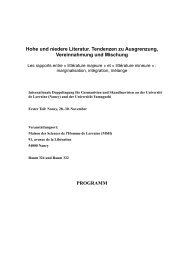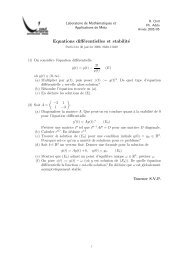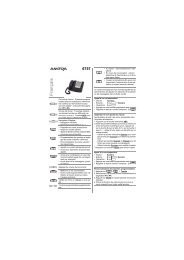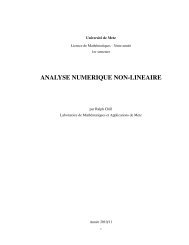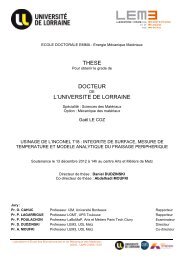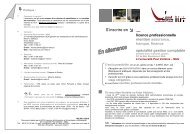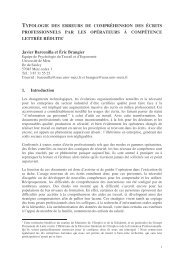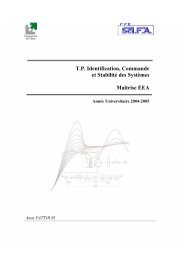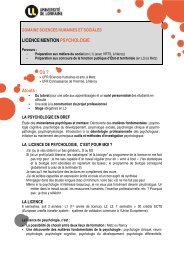T. P. Traitement du Signal Maîtrise E.E.A. - LASC
T. P. Traitement du Signal Maîtrise E.E.A. - LASC
T. P. Traitement du Signal Maîtrise E.E.A. - LASC
You also want an ePaper? Increase the reach of your titles
YUMPU automatically turns print PDFs into web optimized ePapers that Google loves.
Accessing Filter Parameters<br />
Accessing Filter Parameters<br />
You can access filter parameters in the following two ways.<br />
• “Accessing Filter Parameters in a Saved Filter”<br />
• “Accessing Parameters in a Saved Spectrum”<br />
Accessing Filter Parameters in a Saved Filter<br />
The MATLAB structures created by SPTool have several associated fields,<br />
many of which are also MATLAB structures. See the MATLAB documentation<br />
for general information about MATLAB structures.<br />
For example, after exporting a filter filt1 to the MATLAB workspace, type<br />
filt1<br />
to display the fields of the MATLAB filter structure. The tf, Fs, and specs<br />
fields of the structure contain the information that describes the filter.<br />
The tf Field: Accessing Filter Coefficients<br />
The tf field is a structure containing the transfer function representation of<br />
the filter. Use this field to obtain the filter coefficients;<br />
• filt1.tf.num contains the numerator coefficients.<br />
• filt1.tf.den contains the denominator coefficients.<br />
The vectors contained in these structures represent polynomials in descending<br />
powers of z. The numerator and denominator polynomials are used to specify<br />
the transfer function<br />
Hz ()<br />
where:<br />
Bz () b( 1) + b( 2)z ----------<br />
– 1 + L + bnb ( + 1)z = = -----------------------------------------------------------------------------------------<br />
– m<br />
Az () a( 1) + a( 2)z – 1 + L + ana ( + 1)z – n<br />
• b is a vector containing the coefficients from the tf.num field.<br />
• a is a vector containing the coefficients from the tf.den field.<br />
• m is the numerator order.<br />
• n is the denominator order.<br />
6-35



